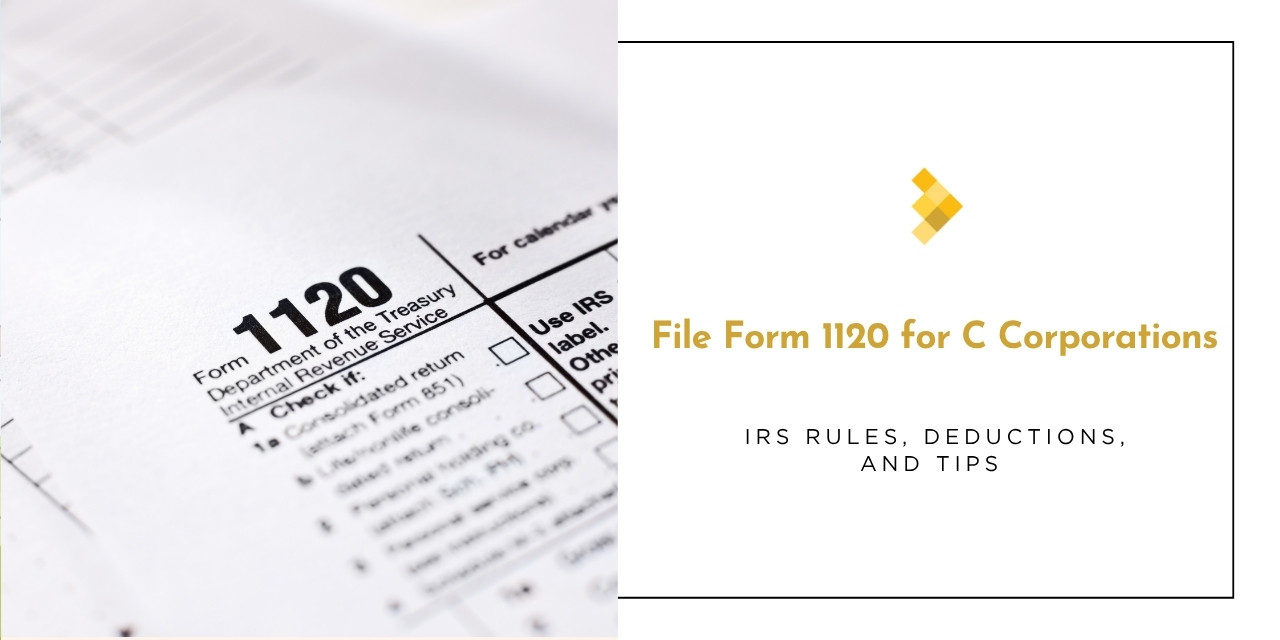Did you know the IRS can penalize your corporation even if it reports zero income? That’s because every C corporation must file Form 1120, no matter what. For many businesses, this return isn’t just a formality. It is the key to staying compliant, protecting deductions, and avoiding costly mistakes.
In this guide, we’ll cover everything you need to know about Form 1120, including who must file, deadlines, deductions, and the latest IRS updates.
What is Form 1120?
Form 1120 is the corporate income tax return that C corporations must file with the IRS each year. It shows the corporation’s financial activity, including income, expenses, deductions, and credits, and is used to calculate how much federal income tax the corporation owes.
In short, it’s the IRS’s way of measuring your corporation’s profits and ensuring the right tax is paid. For official details, businesses can also review the form 1120 instructions published by the IRS.
Which Corporations Need to File Form 1120
Form 1120 must be filed by all domestic C corporations, whether they made a profit, reported a loss, or had no activity during the year. As long as the entity is legally registered as a C corporation, the IRS expects this return.
This includes:
• Active C corporations with taxable income.
• Corporations with losses, since reporting them allows loss carryforwards.
• Inactive corporations that are still legally incorporated.
• Foreign-owned domestic corporations, even if they have little or no U.S. income.
• LLCs that elect to be taxed as corporations, since they are treated as C corporations for tax purposes.
• Corporations engaged in farming that are taxed as C corporations.
• Corporations with an ownership interest in a Financial Asset Securitization Investment Trust (FASIT).
• Qualified Opportunity Funds and corporations with a Qualified Opportunity Investment.
In short, if your business is classified as a C corporation under U.S. law or treated as one for tax purposes, you are required to file Form 1120 every year.
Filing Deadlines & Extensions
• Calendar year corporations must file Form 1120 by April 15 of the following year.
• Fiscal year corporations file by the 15th day of the 4th month after the fiscal year ends.
• If the deadline falls on a weekend or holiday, it moves to the next business day.
• Extensions: You can request an automatic 6-month extension using Form 7004, but any tax owed is still due by the original deadline.
Urgent Reminder: A corporation with a fiscal tax year ending June 30 must file Form 1120 by the 15th day of the 3rd month after the end of its tax year, which means the deadline is September 15. If an extension is filed, the new deadline becomes March 15 of the following year.
For corporations that follow a calendar year (ending December 31), the original deadline is April 15. With an approved extension, the due date moves to October 15.
Penalties for Late Filing and Payment
The IRS enforces strict penalties when corporations fail to file or pay their taxes on time. Understanding how penalties apply to Form 1120 can help you avoid unnecessary costs:
ChatGPT said:
These penalties highlight the importance of filing Form 1120 accurately and paying any taxes owed by the deadline.
IRS Updates for 2025
• Late Filing Penalties – If a corporation files Form 1120 more than 60 days late, the minimum penalty has increased. The IRS will now charge the smaller of the unpaid tax or $510, making timely filing more important than ever.
• CAMT Relief – With the new Corporate Alternative Minimum Tax (CAMT) rules, some corporations may face unexpected underpayments. The IRS is offering relief from penalties in certain cases, giving businesses more time to adjust to the new requirements.
• Online Tools – The IRS has upgraded its digital services, making it easier for corporations to get account transcripts, make secure e-payments, and access filing assistance online. This shift encourages more businesses to e-file and manage tax compliance electronically.
Step-by-Step Guide to Filing Form 1120
Gather Financial Records
Collect income statements, balance sheet, retained earnings, and any records of foreign income. These documents form the base for completing the return.
Identify Your Tax Year
Confirm whether your corporation follows a calendar year (ending December 31) or a fiscal year (any 12-month period ending on the last day of another month). This determines your filing deadline.
Provide Basic Information
Fill in your corporation’s legal name, address, Employer Identification Number (EIN), tax year, date of incorporation, and total assets at year-end.
Report Income
Enter gross receipts, cost of goods sold, dividends, interest, capital gains, and any other income.
Claim Deductions
Deduct allowable expenses like salaries, rent, advertising, insurance, depreciation, and charitable contributions. These lower your taxable income.
Apply Credits
Reduce your tax bill by applying credits such as the R&D credit, energy credits, or the foreign tax credit.
Calculate Taxable Income
• Subtract allowable deductions from total income.
• Apply any Net Operating Loss (NOL) or special deductions.
Compute Tax Liability
Use Schedule J to calculate your tax. Check whether the Corporate Alternative Minimum Tax (CAMT) applies to your business.
Attach Required Schedules
Understanding Form 1120 schedules is essential because each one serves a different purpose. Add schedules that apply to your corporation:
Include Common Additional Forms
Depending on your corporation’s activities, you may also need to file:
• Form 1125-A – Cost of Goods Sold
• Form 1125-E – Compensation of Officers
• Form 4562 – Depreciation and Amortization
• Form 3800 – General Business Credit
• Form 1118 – Foreign Tax Credit for Corporations
• Form 2220 – Underpayment of Estimated Tax by Corporations
Sign and File
A corporate officer (such as president or treasurer) must sign the return. If more time is needed, submit Form 7004 before the deadline to request an extension.
Maintain Records
Keep a copy of your Form 1120, all schedules, and supporting documentation for at least three years.
Following these steps ensures your Form 1120 is complete, compliant, and less likely to draw IRS scrutiny.
Payment Methods for C Corporations
C corporations have several options for paying the taxes they owe, and choosing the right method can help avoid delays or penalties:
• EFTPS (Electronic Federal Tax Payment System): This is the standard method required for most corporations. Payments can be scheduled in advance, made 24/7, and tracked online. Registration is free, but it may take time to set up, so new corporations should enroll early.
• Same-Day Wire Transfer: For urgent or last-minute payments, corporations can wire funds directly through their bank to the U.S. Treasury. While effective, banks may charge fees for this service, and cutoff times vary, so it’s best used as a backup.
• Check or Money Order with Form 1120-V: Some smaller corporations that are not required to e-file may still pay by check or money order. In this case, the payment must be mailed along with Form 1120-V, Payment Voucher.
No matter which method is chosen, timely payment is critical. The IRS charges penalties and interest for late or insufficient payments, even if Form 1120 was filed on time. Setting reminders or using EFTPS to schedule payments ahead of deadlines can help corporations stay compliant.
Electronic Filing Requirements
Most corporations must now file Form 1120 electronically. If a corporation files 10 or more returns in a year, such as W-2s, 1099s, or payroll forms, it is required to e-file its corporate income tax return as well.
E-filing is the default method for C corporations, and only those with an approved waiver from the IRS can file on paper. Waivers are granted in limited cases, usually for hardship or technical issues.
State Filing Requirements
Along with the federal Form 1120, most states also require corporations to file a separate state corporate tax return. Each state sets its own rules for deadlines, rates, and forms, so the requirements can vary widely.
• Delaware and Nevada do not impose a traditional corporate income tax but instead charge annual franchise fees.
• California, New York, and Texas apply their own corporate income or franchise taxes, often at different rates than federal rules.
Because of these differences, corporations must review their state’s Department of Revenue website to confirm specific filing requirements. Ignoring state filings can lead to penalties even if the federal return is submitted on time.
Carryovers and Special Items
Form 1120 allows corporations to carry certain items forward or backward to reduce future liabilities. These rules are especially important for long-term tax planning:
• Net Operating Losses (NOLs): Can be carried forward indefinitely, though they may only offset up to 80% of taxable income in the year applied.
• Capital Losses: May be carried back three years and carried forward five years to offset capital gains.
• Credit Carryforwards: Business credits such as R&D or foreign tax credits can often be carried forward if they cannot be fully used in the current year.
Used properly, these carryovers can provide meaningful savings in years when income and tax liability are higher.
Key Deductions and Credits
C corporations filing Form 1120 should carefully review available deductions and credits to avoid missing tax-saving opportunities:
These deductions and credits directly reduce taxable income or taxes owed, making them critical to accurate filing.
IRS Audit Risks
While most returns are processed without issue, certain factors may increase the chance of an IRS review or audit of Form 1120:
• Claiming large or unusual deductions without proper documentation.
• Significant differences between book income and taxable income reported on Schedule M-1.
• Foreign income or assets that are reported inconsistently or not supported.
• Late or missing estimated tax payments, which signal compliance problems.
• Aggressive use of NOLs or credit carryovers that appear out of line with the corporation’s history.
Maintaining accurate records and filing consistently reduces the risk of audit and helps corporations respond confidently if one occurs.
Tips for Corporations
• Use payroll and accounting software to simplify record-keeping.
• Make quarterly estimated tax payments to avoid penalties.
• Keep tax reserves aside for expected liabilities.
• Review the IRS Form 1120 instructions periodically to stay updated on changes.
• Seek professional tax advice for complex deductions or international operations.
By following these tips, corporations can handle Form 1120 with more confidence and reduce the risk of costly mistakes.
Conclusion
Filing Form 1120 may seem complex, but with the right preparation, accurate records, and awareness of deadlines, it becomes a manageable part of running a corporation. Staying proactive not only prevents penalties but also helps your business stay focused on growth.
Book your free consultation today and let our team simplify Form 1120 filing for your corporation.






4 Comments
Pramod Gupta
Very Informative. Thanks MAS
Team Maspartner
Appreciate your feedback.
Puneet Sehgal
As expected from MAS, perfectly detailed and precise.
Team Maspartner
Thank you for the appreciation!